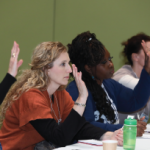Frailty & Sarcopenia Screening
Dr. Bühring also recommended other tools that can be helpful for assessing frailty and sarcopenia. Sarcopenia is much more common in people with rheumatoid arthritis than in people in the general population. And, like multimorbidity, sarcopenia and consequent poor muscle function negatively impact daily functioning as measured by the Health Assessment Questionnaire (HAQ).11
Practitioners can choose among several approaches to screen for sarcopenia, including the SARC-F questionnaire and the Short Physical Performance Battery.12,13 The recent European Consensus guidelines on sarcopenia provide even more detail about the steps needed to make a formal diagnosis.14
A related but somewhat different parameter, frailty, also negatively impacts daily functioning and HAQ scores.15 The Fried Index is a validated measure that is easy to perform in a clinical setting, as is the Simple FRAIL Questionnaire Tool (Fatigue, Resistance, Aerobic, Illnesses, Loss of Weight).16,17 Because one component of frailty is muscle weakness, assessing for frailty somewhat captures sarcopenia status as well.
Dr. Bühring emphasized that regular and systematic use is much more important than the specific tools employed. “Pick a tool that you are comfortable with and go with it,” he said. “The key is that you know what your tools are, and you know them well enough that you don’t have to look up how to do them on the spot.”
Treatment & Interdisciplinary Collaboration
Both Dr. Bühring and Dr. Makris emphasized the need for interdisciplinary collaboration when dealing with these complex patients. When a rheumatologist identifies a potential issue, such as impaired cognition, it doesn’t mean they alone are responsible for formal diagnosis and treatment. Rheumatologists should have a network of people they can ask for consultations and refer patients to, ideally others with experience working with older patients with rheumatic disease.
Depending on the context, this may mean other doctors (e.g., rehabilitation specialists, geriatricians, orthopedists, psychiatrists) or other professionals, such as physical therapists, occupational therapists, clinical psychologists, social workers or others.18 “It’s always worth picking up the phone to introduce yourself and also to [learn about] their approach to patient care,” said Dr. Makris.
Dr. Makris argued that for many older adults with complex conditions, nonpharmacological modalities can play a key role in augmenting treatment. She explained that multiple non-pharmacological interventions now have enough evidence behind them that rheumatologists can use them with their patients, although no single approach works for everyone.
“I typically focus on these movement therapies [such as walking programs, tai chi, yoga, aquatic therapy],” Dr. Makris said. “I think that all of our older adult patients could benefit from increasing physical activity, and that could improve both the pain and the mental health comorbidities.” Other approaches, like mindfulness techniques or many others, may also be appropriate.18

